|
|
Bioactive Inorganic Materials in Soft Tissue Regeneration
WU Chengtie, CHANG Jiang
2025 Vol. 40 (8): 847–848
 Abstract
Abstract(
730 )
 HTML
HTML(
17)
 PDF
PDF(223KB)(
186
)
Human soft tissue generally refers to the sum of all connective tissues in the body excluding bones and joints, including skin, muscles, blood vessels, nerves, etc., and is the most widely distributed and largest proportion of tissues in the human body. Soft tissues are soft and elastic, which closely connect various tissues and organs, and play a crucial role in supporting, protecting, and maintaining the normal physiological functions of human body. However, large-area and large-volume soft tissue injuries caused by accidents, diseases, and surgery significantly affect health and quality of life of patients, and remain one of the significant challenges in clinical medicine. Due to its effective performance of repairing damaged tissues, autologous transplantation has been regarded as the gold standard in clinical applications for many years, while it faces the disadvantages of limited donor sources and secondary trauma. Therefore, it is urgent to develop novel bioactive materials with suitable compositions/structures and excellent performance to promote soft tissue regeneration. Since the bioactive glass, the first-generation inorganic biomaterials, with excellent biocompatibility and tissue integration functions invented by Prof. Larry Hench from the United States in 1969, the research curtain of bioactive inorganic materials has been opened, receiving widespread attention from material scientists and medical doctors, and entering a fast track of rapid development. Inorganic biomaterials possess highly controllable chemical compositions and macro/nano topographical structures, offering unique advantages in regulating cell differentiation and inducing tissue regeneration. Over the past decades, researches have mainly focused on the effects of inorganic biomaterials on regulating the differentiation behaviors of bone-related cells and hard tissue regeneration including bone and teeth, effectively addressing several clinical problems. Interestingly, recent studies demonstrate that inorganic biomaterials also have the capacity to regulate the bioactivity and specific differentiation of various soft tissue-related cells, including vascular endothelial cells, nerve cells, hair follicle stem cells, etc. These studies preliminarily confirm the potential application of inorganic biomaterials in repairing soft tissue injuries, greatly expanding the application scope of inorganic biomaterials. In recent years, our group has performed numerous studies on the application of bioactive inorganic materials for soft tissue regeneration, and achieved some representative results. To showcase the latest research progress of Chinese research teams in the application of inorganic biomaterials to soft tissues regeneration including skin, nerves, myocardium, etc., and attract more researchers to participate in the basic research and clinical translation of inorganic biomaterials, Prof. Chang Jiang and I are invited by the editorial office of Journal of Inorganic Materials to serve as guest editors for a special issue on the theme of "Inorganic Biomaterials for Soft Tissue Regeneration". This special issue includes review articles on the latest researches from well-known teams, including Shanghai Institute of Ceramics, Chinese Academy of Sciences, Xi'an Jiaotong University, Sichuan University, Shanghai Normal University, etc., covering many interesting aspects such as vascularized skin regeneration, hair follicle regeneration, innervated tissue regeneration, myocardial regeneration, and organoid development. We hope that this special issue can help researchers gain a deeper understanding of the latest developments and broad application prospects of inorganic biomaterials in the field of soft tissue regeneration, and promote close collaboration among researchers from various fields and disciplines to jointly advance the development of inorganic biomaterial science. We expect that more innovative inorganic bioactive materials will emerge to solve numerous clinical problems related to soft tissue regeneration in the future, ensuring human life safety and health.

|
|
|
Inorganic Biomaterials on Regulating Neural Cell Function and Innervated Tissue Regeneration: A Review
ZHANG Hongjian, ZHAO Ziyi, WU Chengtie
2025 Vol. 40 (8): 849–859
 Abstract
Abstract(
884 )
 HTML
HTML(
43)
 PDF
PDF(13535KB)(
260
)
In regard to the crucial role of nerves in tissue regeneration, developing tissue engineering scaffolds with neural-activities has attracted more attention. Recently, inorganic biomaterials have been extensively used in regulating neural cell functions and innervated tissue regeneration due to their advantages of highly controllable chemical compositions, micro/nano topographical structures, and excellent physicochemical properties. This review firstly introduces the typical used inorganic biomaterials for neural regulation, including bioceramics and electroactive materials, and then elaborates on their biological effects of enhancing neural cell viabilities and functions through modulating cell behaviors, regulating immune microenvironment, and constructing electroactive microenvironment. Subsequently, recent progress of inorganic biomaterials on various innervated tissue regeneration, such as spinal cord, peripheral nerves, skin, skeletal muscles, and cavernous tissues, is summarized. Finally, the current challenges and future perspectives of inorganic biomaterials in innervated tissue regeneration are discussed.
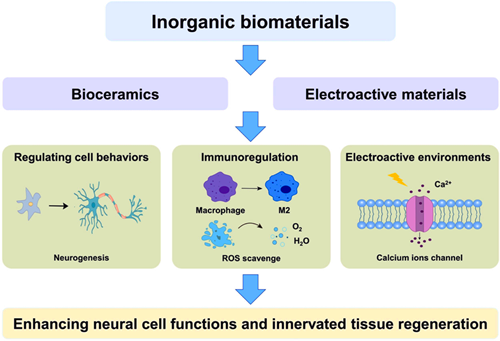
|
|
|
Advances in Regulation of Damaged Skin Regeneration by Two-dimensional Inorganic Materials
XIAO Xiaolin, WANG Yuxiang, GU Peiyang, ZHU Zhenrong, SUN Yong
2025 Vol. 40 (8): 860–870
 Abstract
Abstract(
819 )
 HTML
HTML(
10)
 PDF
PDF(3266KB)(
202
)
Two-dimensional (2D) inorganic materials, as a class of inorganic ultrathin nanosheets with single or several atomic layers, exhibit high specific surface area, high electrical conductivity and/or photothermal conversion efficiency. These unique physicochemical properties confer procoagulant, antibacterial, anti-inflammatory, and antioxidant biological effects. In recent years, in view of degradation and metabolism issues, these materials have been explored for modulation of diseased skin tissues, such as full-thickness wounds, burns and diabetic wounds, demonstrating remarkable effects in accelerating wound healing, alleviating infections and improving the inflammatory microenvironment. This review focuses on the unique structure and biological effects of 2D inorganic materials, systematically describes their applications in wound healing and related mechanisms, and looks forward to current challenges and prospects of 2D inorganic materials in the field of skin repair.
|
|
|
Inorganic Bioactive Materials Regulating Myocardial Regeneration
LUO Xiaomin, QIAO Zhilong, LIU Ying, YANG Chen, CHANG Jiang
2025 Vol. 40 (8): 871–887
 Abstract
Abstract(
897 )
 HTML
HTML(
8)
 PDF
PDF(11916KB)(
220
)
Cardiovascular disease is the leading cause of death worldwide, with myocardial infarction (MI) being a serious threat to human health and life. Current pharmacological and surgical interventions primarily serve as palliative measures, failing to address the root cause of cardiomyocyte death post-MI. Recent advances in regenerative biomedical materials, however, offer promising solutions. Inorganic bioactive materials, capable of interacting with cells and tissues to activate cellular responses and modulate tissue regeneration, have garnered significant attention in regenerative medicine and tissue engineering. Silicate-based biomaterials (e.g., bioceramics, bioactive glasses), carbon-based nanomaterials, and metal oxides exhibit remarkable potential in promoting myocardial repair and regeneration. This review highlights the latest progress in inorganic bioactive materials for myocardial regeneration and repair, elucidates their material categories and mechanisms of action, and discusses current challenges in clinical translation, while providing insights into future research directions.
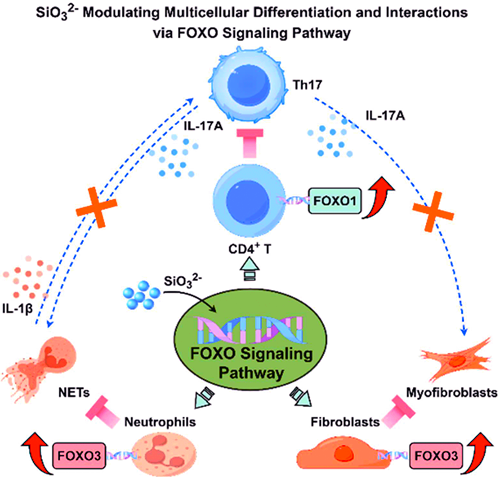
|
|
|
Application of Inorganic Bioactive Materials in Organoid Research
MA Wenping, HAN Yahui, WU Chengtie, LÜ Hongxu
2025 Vol. 40 (8): 888–900
 Abstract
Abstract(
815 )
 HTML
HTML(
14)
 PDF
PDF(37825KB)(
163
)
As an effective in vitro three-dimensional (3D) model, organoids can simulate the structure and function of corresponding tissues/organs, demonstrating broad application prospects in the biomedical field. The construction of organoids relies on the regulation of stem cell behaviors and multicellular interactions. Inorganic bioactive materials possess excellent biocompatibility and bioactivity, showing wide application in the field of biomedical research. Therefore, they can potentially regulate cell behaviors and cell-cell/cell-matrix interactions in the construction of organoids. In this review, the role of inorganic bioactive materials in organoid research was explored, emphasizing their contribution to organoid development and application, and summarizing the critical steps in organoid construction strategies. Subsequently, the biological functions of inorganic bioactive materials, particularly those compatible with key steps in organoid construction, were systematically elucidated, and the key mechanisms by which inorganic bioactive materials promote organoid development and application were emphasized, including their effects on key signaling pathways, regulations of matrix material properties and cellular energy metabolism. In addition, the application of organoids as auxiliary tools to promote the use of inorganic bioactive materials was reviewed. Finally, the strategies for further advancing organoid research by regulating various physical and biochemical clues provided by inorganic bioactive materials were prospected.
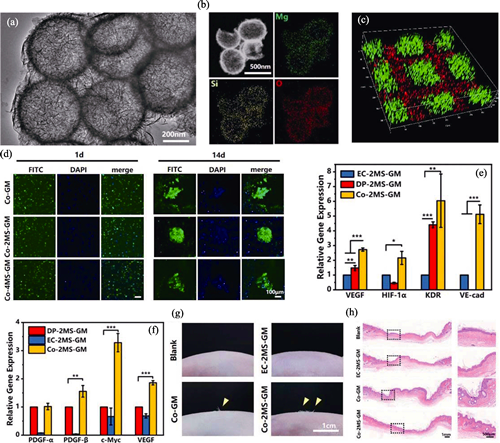
|
|
|
Application of Inorganic Bioceramics in Promoting Hair Follicle Regeneration and Hair Growth
MA Jingge, WU Chengtie
2025 Vol. 40 (8): 901–910
 Abstract
Abstract(
836 )
 HTML
HTML(
13)
 PDF
PDF(9762KB)(
1549
)
Hair loss caused by hair follicle degeneration can seriously affect individuals' quality of life and mental health. However, the clinical treatment methods for hair loss have several limitations. Hair follicle regeneration has emerged as a significant challenge in the field of skin tissue engineering. In recent years, various inorganic materials, particularly bioceramics, have been identified as capable of regulating cell activities by releasing bioactive ions, which positively influences skin tissue repair and hair follicle reconstruction. Herein, the structures of skin tissue and hair follicle are introduced firstly, then the main types of bioceramics that can promote hair follicle regeneration are listed, followed by the related representative studies. Subsequently, the different application forms of inorganic materials in hair follicle regeneration are discussed. Finally, the development direction of bioceramics for hair regeneration is summarized and prospected. This review highlights the potential of bioceramics in promoting hair regrowth, offering new strategies for treating hair follicle damage and hair loss disorders.
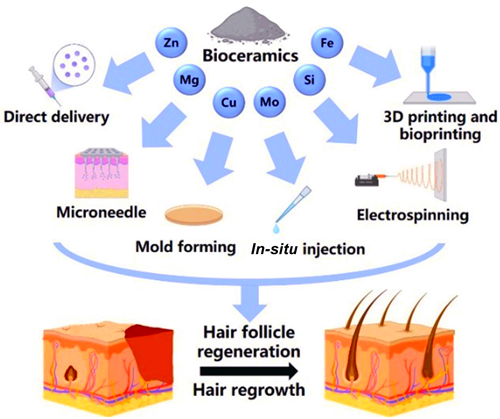
|
|
|
Advances in Silicate Bioceramic/Bioglass for Wound Healing: Effects, Mechanisms and Application Ways
WANG Yutong, CHANG Jiang, XU He, WU Chengtie
2025 Vol. 40 (8): 911–920
 Abstract
Abstract(
788 )
 HTML
HTML(
11)
 PDF
PDF(2162KB)(
258
)
Extensive skin trauma represents one of the most challenging issues in global public health, and its repair and treatment impose a huge economic burden on healthcare systems. Therefore, there is an urgent need to develop an efficient wound dressing that can promote skin regeneration at the wound site. In recent years, silicate bioceramics/bioglasses have received widespread attention and application in the field of wound healing due to their multiple advantages, including promoting angiogenesis, stimulating collagen deposition, and anti-infection properties. This paper provides a concise overview of the mechanisms through which silicate-based bioceramics/ bioglasses contribute to skin regeneration, analyzes their integration with emerging technologies and their applications in wound healing, and summarizes the advantages and limitations of these materials. This review aims to inform and guide the future clinical application of silicate-based bioceramics/bioglasses in wound healing.
|
|
|
Micro-nanoscale Bioactive Glass: Functionalized Design and Angiogenic Skin Regeneration
AI Minhui, LEI Bo
2025 Vol. 40 (8): 921–932
 Abstract
Abstract(
810 )
 HTML
HTML(
14)
 PDF
PDF(2623KB)(
178
)
Bioactive glass (BG) is an important class of amorphous inorganic biomaterials, which has been clinically used in hard tissue repair for many years, exhibiting unique tissue repair activity. Recent studies have found that BG also shows effective repair activity in soft tissue, demonstrating significant application potential. Compared with traditional BG, micro-nanoscale bioactive glass (MNBG) has a unique micro-nano structure, which not only retains its excellent chemical composition but also has a larger specific surface area and higher reactivity. These special structures and properties enable MNBG to exhibit significant application potential in promoting vascularization and skin repair/regeneration. This work focuses on the research progress of MNBG in regulating vascularization and skin regeneration, including the abilities of MNBG to promote vascularization and regulate immune cell function, as well as its antioxidant, anti-inflammatory, and antibacterial properties. These characteristics enable MNBG to effectively stimulate blood vessel formation, reduce inflammation, and inhibit bacterial infection, thus promoting wound healing and tissue repair. This paper summarizes the key research on the role of MNBG in vascularization and skin wound repair and offers recommendations on the existing issues and future research directions in the application of MNBG in skin wound repair, aiming to promote the application transformation of MNBG in the field of skin repair.
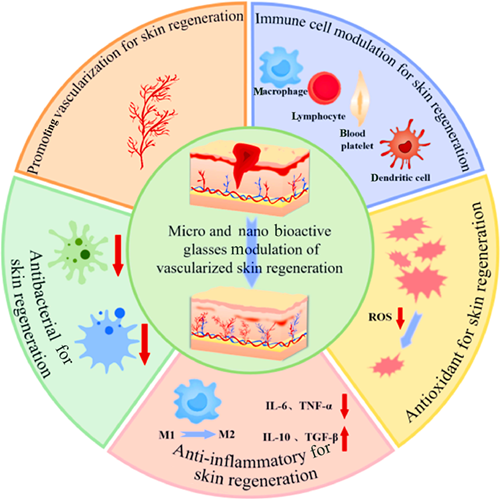
|
|